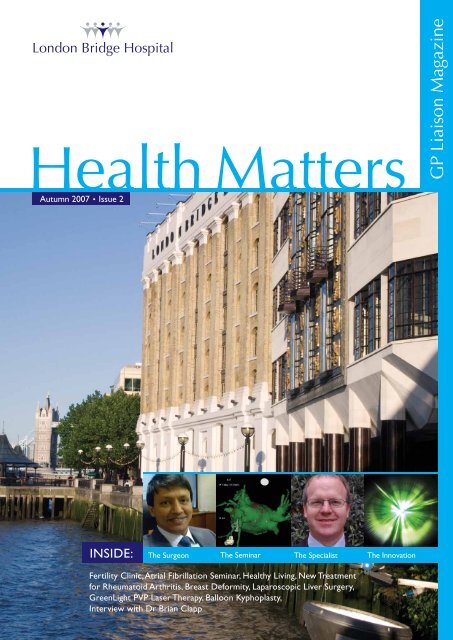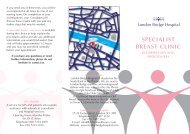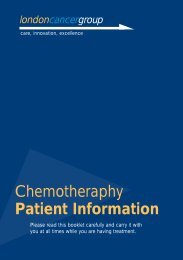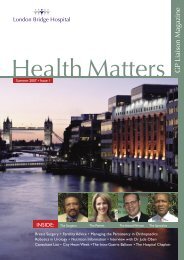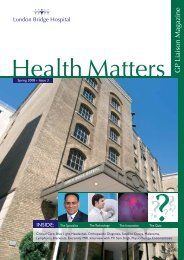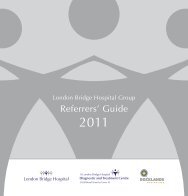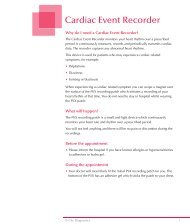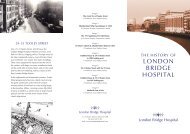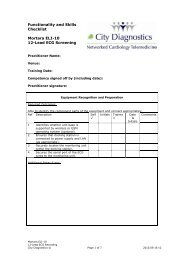Health Matters - London Bridge Hospital
Health Matters - London Bridge Hospital
Health Matters - London Bridge Hospital
- No tags were found...
You also want an ePaper? Increase the reach of your titles
YUMPU automatically turns print PDFs into web optimized ePapers that Google loves.
IntroductionTo our referringGeneral PractitionersI am delighted to introduce our latest GP Liaison Magazine. Thankyou for your support over the past few months, and my very bestwishes for you at a time of year when life gets increasingly franticin the run-up to Christmas. I am pleased to say that the hospitalhas had a successful year to date and we have been well supportedwith capital investment.To update you:At 31 Old Broad Street, we have introduced new liver scanningequipment (Fibroscan) and a new bone densitometer. The Handand Wrist Clinic at the hospital will be moved into the City and weare going to support it with the very latest therapeutic equipment.At <strong>London</strong> <strong>Bridge</strong> <strong>Hospital</strong>, the liver and orthopaedic servicescontinue to strengthen and we hope to become a centre ofexcellence in both specialties. Meanwhile, our adult cardiac surgicalresults have been published, along with those of the leading <strong>London</strong>teaching hospitals, and we compare extremely favourably, particularlywhere high risk patients are concerned.Our Women’s <strong>Health</strong> Centre, at the main hospital site, is thrivingand it has enabled us to create a much more focused outpatientcentre, with plenty of information and rapid access clinics availableto our patients.I very much hope that you fi nd the hospital outpatient servicescontinue to be responsive to your needs. Please do feel free towrite, ring or email me, john.reay@hcahealthcare.co.uk if everyou feel that we can improve. I do hope that you can attend someof our lectures and our evening get-togethers and thank you as everfor your support for this hospital.With kind regards and best wishes.Yours sincerely,John ReayChief Executive Officer2
FeaturesFeaturesp31 Old Broad Street4 The Lister Fertility Clinic now at 31 Old Broad Street4 Urology consultations at 31 Old Broad StreetSeminar5 The Modern Management of Atrial Fibrillation Seminar –with Live Case DemonstrationBalloon Kyphoplasty6 An effective Cement Injection treatment of Back Paincaused by crushed vertebraeArthritis7 New treatments lead to major changes in managementof Rheumatoid ArthritisBreast Deformity8 Diagnosing Tubular Breast DeformityCholecystectomy8 New technique for operation of CholecystectomyLiver Surgery9 Laparoscopic Liver Surgery – a less invasive surgeryGreenLight10 A new laser technique for the management of SymptomaticBenign Prostatic Hypertrophy<strong>Health</strong>y Living11 Functional Foods – Do they really work?Interview12 10 minutes with Dr Brian ClappBreast Screening13 Mammography now available in 3 <strong>London</strong> locationsGP Liaison DepartmentTel: 020 7234 2009Email: gpliaisonlbh@hcahealthcare.co.ukConsultants13 New <strong>London</strong> <strong>Bridge</strong> <strong>Hospital</strong> Consultant ListEvents14 <strong>London</strong> <strong>Bridge</strong> – the destination on your doorstep3
31 Old Broad StreetWorld-Class Fertility ServicesfromNow in the City!With almost 20 years’ experience in the field of assisted conceptionat our flagship clinic in Chelsea, The Lister Fertility Clinic has a longstandingreputation for being one of the largest and most successfulfertility centres in the UK. The Unit is headed by Mr Hossam Abdalla,who is at the forefront of fertility medicine.From preliminary investigations to complex treatments, The Lister Fertility Clinic nowoffers a range of fertility services for couples in a new City location at 31 Old BroadStreet, including:• Fertility Assessment• Ovulation Monitoring and Induction• Intra-Uterine Insemination (IUI)• In Vitro Fertilisation (IVF)• Treatment of Male Factor Infertility (ICSI)• Gamete (Egg or Sperm) and Embryo Donation• Pre-Implantation Genetic Screening (PGS)• Egg, Sperm and Embryo FreezingFor more information, contact us directly on:Tel: +44 (0) 20 7881 4087 Email: city@lfclinic.comMary Power, Unit Manager, The Lister Fertility ClinicAll consultations, ultrasound scans, nurseconsultations and blood tests are availableat 31 Old Broad Street.All theatre and laboratory proceduresare performed at our IVF Unit inChelsea.Whether your patients seek an assessmentof their current or future fertility potential,or need treatment, they can access ourworld-class services without spendingprecious time travelling across <strong>London</strong>.A stone’s throw from Liverpool Street,Bank and Moorgate underground stations,31 Old Broad Street is in the heart ofthe City.Please address referrals, including adaytime contact telephone number forthe patient, to:Mr H I Abdalla FRCOGThe Lister Fertility Clinic (City Clinic)Chelsea <strong>Bridge</strong> Road<strong>London</strong>SW1W 8RHUrology in the City31 Old Broad Street, in the heart of the square mile,is the site of the well established outpatient branchof <strong>London</strong> <strong>Bridge</strong> <strong>Hospital</strong>.4Patients who need an expert urologyconsultation can now also be seen at31 Old Broad Street, complementing theurology facilities at <strong>London</strong> <strong>Bridge</strong> <strong>Hospital</strong>.Since January 2007, Mr Jonathon OlsburghFRCS(Urol), Consultant Urologist at Guy’s<strong>Hospital</strong>, has run a regular outpatient clinicand welcomes both urgent and routinereferrals. Mr Olsburgh is very pleasedto be able to offer a One-Stop Clinic formany urological problems. The 31 OldBroad Street clinic has facilities for urineflow rate tests, flexible cystoscopy, urinarytract ultrasound and MRI scanning.A Well-Man Clinic,including testis andprostate checkup, isavailable. In additionto PSA testing, whenappropriate, the newhighly sensitive andspecific urine-based prostate cancertest uPCA3 is available at 31 Old BroadStreet.Any patient requiring CT scan, daycaseor inpatient surgery has access to all thefacilities at <strong>London</strong> <strong>Bridge</strong> <strong>Hospital</strong>’s mainsite only a short distance away.For further details orappointments, please contacteither the GP Liaison team on:020 7234 2009or Mr Olsburgh on:07949 044980 or020 7188 1543
Seminar – Thursday 7th February 2008Atrial Fibrillation (AF) is the mostcommon cardiac arrhythmiaSeminarFigure 1The ModernManagement of AFSeminar for GPs at <strong>London</strong> <strong>Bridge</strong> <strong>Hospital</strong> with LiveCase DemonstrationProgramme - 7th February 2008Who should have Warfarin?Who should be cardioverted?Is there a cure?Who should use treatmentand what should it be?All of these common questions willbe answered for you at our seminar.AF causes a marked reduction in cardiac performance leadingto breathlessness, syncope and disabling palpitations. It is alsostrongly associated with stroke, a complication which can beavoided with proper use of oral anticoagulants. Despite itsimportance, AF remains poorly understood and there arewide variations in how it is managed by clinicians.Over the past 10 years, there have been dramatic advancesin treatments available for AF, in particular, the developmentof percutaneous catheter ablation. In the past, patients wereconsidered untreatable and the disease was allowed to followits own natural course. However, more recently there hasbeen a drive by many cardiologists to restore and maintainsinus rhythm over the long-term. In parallel with this, however,there have been claims from other cardiologists that this isthe wrong approach, claiming that AF should be managedconservatively, using just Warfarin to prevent stroke, anddrugs such as Digoxin to keep the patient’s ventricular ratecontrolled.A consequence of this ongoing debate is that many nonspecialistsare now confused and uncertain how to best managetheir AF patients. This seminar hopes to clarify AF managementfor GPs by reviewing these controversies and offering simpleguidelines. In addition, a live AF ablation case will be performed(see figure1) which we hope will demystify this procedure anddemonstrate that, for appropriate patients, it is a safe andeffective way of treating this common condition.Figure 1: Left atrium of a patient undergoing AF ablation. Theimage has been reconstructed from a CT scan and is used toguide the ablation catheter around the chamber, so that ablationcan be delivered at the pulmonary veins, the usual source of AF.12:00 Welcome Mark Earley12:00 - 12:20 AF – is it safe to ignore orshould we try and restoresinus rhythm in everyone?12:20 - 12:40 A quick guide to restoringand maintaining sinusrhythmMark EarleySimon Sporton12:40 - 13:00 Warfarin – who needs it? Mark Earley13:00 - 13:15 Catheter ablation of AF –the patient journeyClaire Chitty13:15 - 13:20 Introduction of case Richard Schilling13:20 - 14:00 Lunch14:00 - 16:00 Ablation of paroxysmal AF.Live case performed at<strong>London</strong> <strong>Bridge</strong> <strong>Hospital</strong>by Dr Richard SchillingDuring case Catheterablation of AF: strategyand how it is done16:00 Close of meetingSpeakersClaire ChittyMark EarleyArrhythmia Nurse Specialist,<strong>London</strong> <strong>Bridge</strong> <strong>Hospital</strong>Simon SportonConsultant Cardiologist, St Bartholomew’s<strong>Hospital</strong> and <strong>London</strong> <strong>Bridge</strong> <strong>Hospital</strong>Richard Schilling Consultant Cardiologist, St Bartholomew’s<strong>Hospital</strong> and <strong>London</strong> <strong>Bridge</strong> <strong>Hospital</strong>Simon SportonConsultant Cardiologist, St Bartholomew’s<strong>Hospital</strong> and <strong>London</strong> <strong>Bridge</strong> <strong>Hospital</strong>5
Balloon KyphoplastyBalloon KyphoplastyAn effective ‘minimal invasive’ cement injectiontreatment of back pain caused by a crushed vertebraeReview of Kyphoplasty:• Kyphoplasty is a low risk, minimallyinvasive spinal surgery procedureused to treat common painful andprogressive Vertebral body Collapsesor Fractures (VCFs) that typically gounnoticed.• The VCFs may be caused byosteoporosis or spread of tumourto the vertebral body.• The procedure involves the use ofa balloon to restore the vertebralbody’s height and shape, followedby bone cement augmentation tostrengthen it.• The procedure is usually performedas a daycase and under sedation orgeneral anaesthetic.• The goal of the procedure is to:• minimise pain• allow early mobilisation and hospitaldischarge• improve quality of life.Benefi ts of Kyphoplasty:• Kyphoplasty has several benefi ts:• It is a minimally invasive procedure.• It restores vertebral body heightwith a low risk of cement leakage.• It is well tolerated and associated withstatistically signifi cant improvements inpain and function (published clinical data).• Published clinical data also shows thatpatients benefi t as much as 2 years afterthe procedure (most benefi cial results ifperformed within 6 months of symptom onset).• Offers the additional benefi t of restoringvertebral height towards the pre-fractureanatomy with restoration of normal spinalbalance, and therefore reduces the risk offurther fractures.• This height restoration may, in turn,improve lung mechanics and decreasemuscular and ribcage pain.GuidelinesKyphoplasty is appropriate whenthere is:1. Osteoporotic vertebral collapse causingpersistent activity limitations anddebilitating pain that has not respondedto standard medical treatment (e.g.physiotherapy, analgesics, external bracing,with or without bed rest).RISK FACTORS- Postmenopausal > age 55- Known osteoporosis- Low weight- Steroid use- Previous VCF- Height loss ≥ 2cmsNOSUSPECTED VCF- Refer for standing AP + Lateral x-rayVCF AT CLINICALLY PAINFUL LEVEL?YESMRI + STIREVIDENCE OF OEDEMA?YESNon-healed VCFHigh disability and/orPain score ≥ 4Level of pain, disability,or deformity…SURGICALMANAGEMENT• Kyphoplasty• Vertebroplasty• Open Surgery (if appropriate)HISTORy- Sudden onset acuteback pain- Mechanical painimproved lying flat- Minimal / no traumaor recent fallLEG PAIN AND/OR WEAKNESS?NOHealing VCFNOLow disability and/orPain score ≤ 4NON-SURGICALMANAGEMENT• Pain management• Exercise• Physical therapyPHYSICAL EXAMINATION- Height loss ≥ 2cms- Thoracic hyperkyphosis- Percussion tenderness overfracture site (junctional areas)- Flexion painYESIMMEDIATE REFERRALTO SURGEONIf pain persists ≥ 2 weeks- Consider repeat x-ray studieslooking for further collapse- Another new fracture- Alternative diagnosisAlternative diagnosis, i.e. infection,metastasis, inflammatory disorders,spinal stenosisALL PATIENTSManage underlying osteoporosis• Obtain DEXA to diagnoseosteoporosis• Add Calcium and Vitamin D• Add bisphosphonates• Recommend dietary changesand exercise2. Evidence of progression of vertebralcollapse.3. Presence of neoplasms or other bonepathology causing persisting or progressivepain, progressive bone destruction orimminent risk of vertebral collapse.Kyphoplasty is NOT appropriatein patients with:1. Spinal curvatures, (e.g. scoliosis or kyphosis)due to causes other than osteoporosis.2. Spinal stenosis or disc herniations withnerve or spinal cord compression and lossof neurological function not associatedwith a collapse or fracture.Referral Process (see flow chart):If you suspect a patient hassuffered a vertebral fracture:• Confi rm fracture via x-ray and/or MagneticResonance Imaging (MRI)NICE guidelines (www.nice.org.uk) suggestpatients should undergo conservativemedical management for 6 weeks initially.• If pain persists, then refer to localKyphoplasty specialists (see names ofclinicians) for assessment on the suitabilityfor Kyphoplasty/vertebroplasty.• Following the procedure, NICErecommends that all patients are referredfor physiotherapy and management of theirosteoporosis.6NO RESPONSE IN 6 WEEKSAll referrals to: Mr Khai Lam (Consultant Spinal Surgeon), and/or Dr TarunSabharwal (Consultant Interventional Radiologist). Tel: 020 7234 2009
New TreatmentsLead to major changes in managementof Rheumatoid ArthritisRheumatoid Arthritis (RA) is the most common inflammatoryarthritis and causes severe damage to joints. RA also causesoverwhelming fatigue, early coronary artery disease and ashortened lifespan. However, new approaches to treatmenthave increased the chances of success.Dr Christopher Edwards, Consultant Rheumatologistand Honorary Senior Lecturer Southampton University<strong>Hospital</strong>s and The <strong>London</strong> Lupus Centre.ArthritisFeatures of poor prognosis Rheumatoid Arthritis• High titre RF• Anti-CCP antibodies• High ESR and CRP• Multiple joints involved• Female sexRheumatoid Arthritis causes damage in manydifferent waysRA damages joints due to inflammation in the joint lining(synovial membrane). The process is controlled by a varietyof protein messengers sent between cells called cytokines. Themost important of these is thought to be Tumour NecrosisFactor (TNF). The effect of activated immune cells releasinginflammatory cytokines leads to joint damage and disability.Chronic inflammation can also have negative effects in manyother areas of the body. Individuals with RA may have a shortenedlifespan by up to 20 years. Premature death is often due to earlyischaemic heart disease. Constant inflammation also causesdecreased bone mineral density, increasing the likelihood ofosteoporosis, and produces overwhelming fatigue.Early diagnosisRecent research has shown that better outcomes are achievedwhen RA is diagnosed and treated as early as possible. Therealso appears to be an opportunity in early disease, to divertRA to a more benign course, if treatment can be started soonenough. Individuals of any age with joint pain associated withearly morning joint stiffness lasting more than 30 minutesshould be considered for assessment.Predicting severity; matching treatment to individualpatientsThe best possible treatment of RA requires an attempt to bemade at predicting the likely prognosis of each patient. A numberof features are associated with a poor prognosis in RA. Theseinclude female sex, younger age, multiple joint involvement,presence of RF and anti-CCP antibodies, high ESR and CRP.The best use of traditional DMARDsThere have been major changes in how traditional DMARDs(Disease Modifying Anti-Rheumatic Drugs) are used. Methotrexateis now the treatment of first choice for most patients and isgenerally well tolerated in doses of 7.5-25mg per week. ForDeformity can occur early if RA is untreatedresistant disease, methotrexate may be used in combination withother DMARDs. Intensive monitoring, using validated scoring systemsand frequent review, improves outcomes.Biological therapiesThere are currently three TNF inhibitors available to treat individualswith RA. Infliximab, Etanercept and Adalimumab are all effective attreating the inflammation and joint damage associated with severeRA. Severe RA may also be treated with the anti-B cell therapy,Rituximab or T cell co-stimulation inhibitor, Abatacept. A numberof new agents are in development including, other TNF inhibitors,an IL-6 inhibitor and new B cell inhibitors.ConclusionRA damages joints and, because it has widespread effects on manyother organs, can lead to a shortened lifespan. The best treatmentrequires early diagnosis and assessment of prognosis. TraditionalDMARDs, such as methotrexate, should be instituted early andcorticosteriods can be used until they become effective. Combinationsof DMARDs may be effective if monotherapy fails. Knowing whento increase or change therapy requires careful monitoring for sideeffectsand a regular record of a disease activity. When DMARDsare not effective, new biological therapies can be used.Key messages• Assess prognostic markers• Early therapy with DMARDs• Methotrexate• Consider collateral damage• Monitor disease activity score closely• Consider biological therapiesFor more information on the treatment of Rheumatoid Arthritis please contact Dr Christopher Edwards.Address: The <strong>London</strong> Lupus Centre, 1st Floor, St Olaf House, <strong>London</strong> <strong>Bridge</strong> <strong>Hospital</strong>, 27 Tooley Street, <strong>London</strong> SE1 2PRTel: 020 7234 21557
Breast Deformity | CholecystectomyTubular BreastDeformityMr Roy Ng is a consultant plastic surgeon at Guy’s and StThomas’ <strong>Hospital</strong>s NHS Trust, and at <strong>London</strong> <strong>Bridge</strong> <strong>Hospital</strong>.He has extensive experience in reconstructive and aestheticsurgery of the breast, including postmastectomy, developmentaland postpregnancy deformities. He has a particular interestin the developmental problem of Tubular Breasts. Here, hedescribes the condition and approaches to its management.The diagnosis of Tubular Breast Deformity can go unrecognisedby patients and some doctors, with the condition simplyassumed to be ‘small’ breasts. However, it is a specificdevelopmental abnormality that can cause great distress to theindividual and impact greatly on their psychosocial functioning.The characteristic features of this deformity are a narrow breast base associatedwith a large and herniated nipple-areola complex. As a consequence, the shapeof the breast resembles more a ‘tube’ than a mound. Other terms that have beenapplied to this condition include ‘tuberous breast’, ‘constricted breast’ and even‘Snoopy breast deformity’. There is a spectrum of severity, and one proposedclassification by Heimburg et al 1 is illustrated in Figure 1.Figure 1. Classification of Tuberous Breast DeformityCounselling and TreatmentNew techniquefor operation ofCholecystectomyMr Marshall, a laparoscopic and Upper GIsurgeon, who has been with NewhamUniversity <strong>Hospital</strong> NHS Trust for threeyears, has pioneered a new technique forCholecystectomy operations over the last18 months. An honorary Consultant Surgeonwith Bart’s and <strong>London</strong> Trust, and HonorarySenior Lecturer at the Institute of Cancerat Charterhouse Square, Mr Marshall hasrecently joined the <strong>London</strong> <strong>Bridge</strong> <strong>Hospital</strong>and will be offering this procedureto patients who require aCholecystectomy.The technique employs an ultrasonicdissector (or Harmonic scalpel) asthe sole instrument for dissectionand sealing of the cystic artery andduct. The operation is performed ina retrograde, or fundus first, mannerwhich enhances the display of the anatomyand allows the surgeon to see the operativefield more clearly. The use of the Harmonicscalpel eliminates the need for electrosurgeryin this operation; which is a further benefit tothe patient because of the concerns regardinginadvertent injury to abdominal structuresand ‘smoke’ production. The techniqueenables more than 90% of patients who haveundergone this type of Cholecystectomy, togo home the same day as their surgery. As aresult of this rapid recovery, the techniquehas been selected for presentation at threeinternational meetings over the last 12 months.This unique operative technique hasPatients with Tubular Breast Deformity are often extremely self-conscious at thetime of examination, and must be handled with great sensitivity and patience.They are often relieved when informed that there is a specific diagnosis, andoverjoyed when informed that effective treatment is possible.The deformity is readily corrected surgically. By means of a periareolar incision,the breast base is widened, volume is increased by insertion of a breast implant,and the nipple-areola herniation is corrected by a ‘doughnut’ mastopexy. Thescars are confined to the areolar border, and therefore quite inconspicuous(Figure 2).significantly improved the recoveryperiod and improved the patients’experiences during this historicallyunpleasant procedure. Mr Marshall is anexperienced laparoscopic surgeon; using thisdynamic technique for hernia repairs, bothinguinal and incisional, surgery for refluxdisease, bowel surgery and obesity treatment.The Department of <strong>Health</strong> has picked upon this technique and is looking to useit as the standard for ‘best practice’ forCholecystectomy surgery.Images: Ethicon Endo-Surgery, a divisionof Johnson & Johnson Medical Limited hasprovided the supporting images. However,it is not responsible for any editorial material.8Figure 2. Preoperative and postoperative photographs of a patient withBilateral Tubular Breast Deformity, left more severe than the right.References1Heimburg v.D., Exner K., Kruft S. and Lemperle G. The Tuberous Breast Deformity:Classification and Treatment. British Journal of Plastic Surgery (1996), 49, 339-345.Mr Roy L. H. Ng, MA DM FRCS (Plast)Consultant Plastic Surgeon<strong>London</strong> <strong>Bridge</strong> <strong>Hospital</strong>www.royng.co.ukMr Marshall
A liver resection is anoperation to remove a partof your liver. It is usuallyperformed because the liverhas one or more tumours init. The liver is one of the feworgans in the body that is ableto re-grow. Up to 80% of theliver can be removed, and thehealthy liver will re-grow inapproximately 8-12 weeks.Mr Parthi SrinivasanLaparoscopic Liver SurgeryLiver Surgeryat <strong>London</strong> <strong>Bridge</strong> <strong>Hospital</strong>Why do I need this operation?You need this operation because it is the mosteffective way of removing the tumour(s) in yourliver.What are the likely benefits?Surgical removal of the tumour(s) offers the onlypotential cure. The intended benefit is that theoperation will extend your life expectancy; thatis, you will live longer having had the operationthan if you do not.How is the operation performed?Liver surgery is traditionally performed by anopen operation through an incision that oftenspreads across both sides of the upper part ofthe abdomen. We first disconnect the bloodsupply to the part of the liver that carries thetumour(s). We then cut through the liver usingspecial devices that help us minimise the bloodloss during the surgery, although sometimes ablood transfusion may be required.More recently, liver tumours have been safely andsuccessfully removed by ‘keyhole’ (laparoscopic)surgery. However, laparoscopic surgery is notsuitable for all patients. This is for a number ofreasons including, not all tumours can be removedby laparoscopic surgery, you may have othermedical conditions or you may have had previousabdominal surgery.In principle, laparoscopic liver resection is thesame as an open operation, but is performedthrough smaller cuts. Whenever we do alaparoscopic operation, however, there is a chancethat we may need to convert to a traditional openoperation, if faced with a difficulty that we cannotovercome by laparoscopic surgery. The chance ofa conversion to open surgery may be as highas 1 in 10 patients (10%). Laparoscopic surgeryis carried out through a few small cuts on theabdomen, with the use of gas (carbon dioxide)to inflate the abdomen. The operation is thenperformed using a special camera to visualise theliver, and special instruments. Sometimes, one ofthe cuts is made longer than others in order forthe surgeon to place one hand in the abdomento help with the surgery (this is called hand-assistedlaparoscopic surgery) and through which thesurgeon finally removes the resected part ofthe liver.For both types of liver surgery, after the tumourshave been removed a glue-like substance is usuallypoured or sprayed onto the liver to help preventbleeding after the operation. Everything is carefullychecked and then the incision is closed with severallayers of stitching.Before any surgery, open or laparoscopic, theteam will assess your clinical condition and reviewyour scans to determine how your tumour(s)could be best removed. All your tests andscans will be reviewed by a team of doctors(the multidisciplinary team), which includesyour consultant. The team will recommend thetreatment it feels will be best for you. Obviously,this recommendation will be thoroughly discussedwith you before a final decision about treatmentis made.If it was not clear from your radiology test orother scans, whether the tumour is removable,your surgeon may carry out a diagnostic test calleda laparoscopy (key-hole operation) to evaluatethe tumour further. If this shows that the tumourhas spread outside of the liver or bile ducts, thesurgeon will not carry out the formal resection.What are the risks?Some risks are common to all operations, suchas chest infection and blood clots forming in yourveins (DVT) or in the lungs (pulmonary embolus).However, there are also specific risks associatedwith liver surgery:1. Bleeding: the liver is well supplied with bloodand one of the major risks of liver surgeryis bleeding. You will lose blood during theoperation and this will be replaced with bloodtransfusions as required. Occasionally, bleedingcan occur after the operation and a furtheroperation may be necessary to stop this.Specific blood will be kept ready for you,should you need a transfusion.Transfusion itself carries some risks and wouldnot be given, except when absolutely necessary.If you have any objections to receiving bloodor blood products (such as platelets), it isessential that you inform your surgeon and/oranaesthetist before your operation.2. Bile leak: the liver can leak bile from whereit has been cut. If your liver does leak bile inthis way, then other procedures may berequired to control this. The reconnections(or anastomoses) that the surgeon createsduring the operation can sometimes leak,and if this happens, then further drains (todrain the leaking fluid to the outside) maybe necessary. If this happens, you may needto return to theatre for further surgery,although this is rarely necessary.3. Liver decompensation: if your tumour(s) arelarge or dispersed within the liver, then a largepart of your liver may have to be removed.This will leave your body with a much smalleramount of liver. As explained earlier, in timethis liver will re-grow to take the place of theliver that has been removed. However, in theshort-term after the operation, your smallerliver may struggle to do all that it is meant to.The symptoms of this can be jaundice (yourskin becomes yellow) and a build up of fluidin your abdomen. These problems will usuallysettle down after a week or two. In a very smallnumber of patients, this may be associated withother organs not functioning properly, such aslow blood pressure, pneumonia and kidneyfailure.4. Infection: this may involve the wound, the drainsites or the inner organs. Antibiotics will be givento you at the time of surgery to try to preventan infection developing.5. Advanced disease: as noted earlier, sometimesit is not clear from radiology or other scanswhether or not the tumour is removable. It maynot be until you are actually on the operatingtable that it is discovered that the tumourcannot be removed.What happens before the operation?Once surgery has been agreed with you as thefavoured option, you will be asked to attend a preassessmentclinic to assess your fitness for surgeryand answer questions. This usually takes half a day;during this, the operation will be explained in detailand informed consent will be taken from you forthe procedure. An anaesthetist will explain theanaesthetic process and discuss the post-operativepain relief options. This is usually in the form ofepidural analgesia, where a small tube is insertedinto your back to deliver the pain relieving drugs.Alternatively, a patient control analgesia pump (orPCA) will be offered. A PCA allows you to controlyour own dosage of pain relief, delivered througha drip in your arm, by pressing a small button.Please use this opportunity to ask the surgeons,nurses or anaesthetists any questions that you have.On admission, you will be given information aboutthe expected date of your discharge from hospital.This is to help you, and the staff caring for you, toplan and prepare for your return home.The day before the operation, you must not eator drink anything after midnight as your stomachneeds to be as empty as possible for the generalanaesthetic you will be given for this operation. Thismay be given to you when you are in the operatingtheatre itself, so don’t worry if you are still awakewhen you are first taken into the theatre.If you have any further queries, please do nothesitate to contact me on: 020 7234 2730Mr Parthi Srinivasan, Consultant Liver andPancreatic Surgeon, <strong>London</strong> <strong>Bridge</strong> <strong>Hospital</strong>.9
GreenLightGreenLightAn average GP practice with 2000 patients will have approximately150 men registered with urinary symptoms severe enough toconsider seeking treatment at some point in time.Traditionally, the successful management ofsymptomatic Benign Prostatic Hypertrophy(BPH) has been Transurethral Resection ofthe Prostate (TURP), which was viewed byboth surgeons and General Practitioners asthe gold standard procedure, given its provenefficiency and long-term durability.When the GreenLight PVP laser therapywas introduced to the UK five years agoby Consultant Urological Surgeon, MrGordon Muir, the laser technique not onlydemonstrated comparable advantages tothose of TURP, but also highlighted theunique benefits of being a daycase, withreduced blood loss, few complications(if any) and minimal morbidity.In 2004, the GreenLight laser procedureat King’s College <strong>Hospital</strong> received the UKClinical Excellence Award for Innovation,soon followed by the approval of theNational Institute for <strong>Health</strong> and ClinicalExcellence (NICE). Today, more than 1000urologists over 30 countries, (many trainedby Mr Muir), perform the minimal invasiveoperation and over 150,000 patients havesuccessfully been treated.In January this year, Executive Director, JohnReay, decided to equip the hospital with themost advanced model of the GreenLight, theGreenLight HPS, with a view to providing hispatients with a laser surgical alternative toTURP, that had proven comparable benefits.Mr Gordon Muir, who has performed over1000 GreenLight operations and who wasthe first surgeon in Europe to use the HPS,confirmed over 95% success rate in men withcatheters for retention of urine, thanks to thenew technology and reported overall excellentresults from a surgical perspective, coupledwith very positive patient feedback.Mr Muir also observed that the HPS definitelysped up the process of removing obstructingprostate tissue, allowed more precision whencompared with its predecessor, reduced timeunder anaesthesia and, ultimately, increasedsafety for patients.What is the GreenLight laser?The GreenLight PVP technology releaseshigh powered laser energy into the cells bymeans of continuous saline irrigation, whichis then absorbed by tissue and haemoglobin,leading to a rapid heating of cells andvaporisation of tissue.Similarities with TURP• Greater than 100% improvement in urinaryflow rates• Over 50% decrease in symptoms• Spontaneous voiding for patients withurinary retention• Immediate removal of the prostatic bladderoutlet obstruction• Comparable operative time• Proven capabilityLong-term durabilityObservations of the GreenLight PVP duringclinical studies concluded to the durablecapability of the procedure and its long-termoutcomes, with significant improvements inmaximum urinary flow rate. 4-5 year followupfrom a number of International centres,including ours, suggests positive durable results.Advantages over TURPClinical studies have shown a low risk ofmainly minor adverse events. TURP can beaccompanied by risks of postoperative urinaryretention, infection, incontinence, erectiledysfunction, impotence, blood transfusion,capsular perforation, clot retention.With the GreenLight laser therapy, the risksof serious bleeding, TUR Syndrome anderectile dysfunction are close to nil. Economicstudies have highlighted the benefits of theGreenLight, in terms of in-hospital costs, andmostly, patients are able to return to normalactivity very rapidly.Large ProstatesTraditionally, open prostatectomy was theoperation of choice for patients with largeprostates, due to the relative inability ofTURP to resect larger glands over 80-100mldue to the risks of TUR Syndrome andsevere bleeding. Since then, the GreenLightlaser therapy has proved to be a very safeoption in treating these large prostates, andmany of these patients can even be treatedin a daycase setting.TUR SyndromeTURP carries a significant risk of absorbingthe irrigating fluid that may cause pulmonaryand cerebral oedema, in extreme casesleading to ITU treatment. Our research onthe GreenLight laser has shown that thispotential complication is abolished.High Risk PatientsFor patients on anticoagulant therapies, withbleeding disorders or at risk of cardiovascularco-morbidity, the GreenLight laser procedureoffers a reasonable surgical alternative due toits haemostatic nature, significantly decreasingthe risks of bleeding, clot retention, transfusion,sometimes seen with TURP.Patient Benefits• Immediate symptom relief• Rapid flow rate improvement• Fast recovery times• Daycase procedure with somepatients resuming work thefollowing dayPatient Programme andOnline CPD WorkshopGeneral Practitioners wishing to illustratethe procedure to their patients can requesta free patient information CD.We understand the importance ofContinuing Professional Development andas such, we are also offering an onlineworkshop for the GreenLight procedure.To obtain details on eitheroption simply call us on:07738 287764101 GreenLight is a trademark of American Medical Systems Inc. 2 Mr Gordon Muir is an International Mentor for the GreenLight procedure and a member of the Renaissance <strong>Health</strong>care Group.3 Based on short-terms results since 2002. 4 Data presented at the European, American and British Annual Urological Meetings, and published in a number of international journals.
Functional Foods –There are manyfunctional foodson the markettoday in the formof ‘quick shot’yoghurt drinks...but what do theyreally do?Do they really work?<strong>Health</strong>y LivingProducts available?How do they work?What is the evidence?How much shouldI have?Is it safe to use themwith cholesterolloweringmedication?Cholesterol Lowering –Plant stanols and sterolsBenecol, Flora pro-activ, Danone Danacol andMini colThey reduce cholesterol absorption from the gut.Both the stanols and sterols have a similar effect,one is not signifi cantly better than the other.2-3g of stanols and sterols per day is the amountthat research has shown to give a benefi cial effecton cholesterol lowering.The benefi cial effect only impacts if therecommended dose is consumed daily.Having more than the recommended amount willhave no greater effect on lowering your cholesterol.The benefi cial effect is lost when you stop consumingthe required amount daily.You require the benefi cial dose of 2-3g of stanolsand sterols per day.If you decide to use these foods, they should beused in place of similar foods you may currently beusing, as these products are more expensive thanstandard spreads, yoghurts and milk.Products containing stanols and sterols are nota substitute for lipid-lowering medication.However, people taking such medication canconsume these products in addition, as they havedifferent methods of action. The overall effect oflowering cholesterol may be greater.Gut <strong>Health</strong> – ProbioticsYakult, Danone Actimel (have suffi cient bacteriato have effect)Taking probiotics may help to restore the balanceof the gut fl ora.But potentially they could:• Help the body’s defence system by inhibitingthe growth of harmful bacteria• Help to improve digestion and possibly IrritableBowel Syndrome• Help symptoms associated with lactose intolerance• Help to improve quality of life for peoplewith Infl ammatory Bowel DiseaseThe evidence is still being obtained and more researchis required, but they do have the potential to improvegut health.As the evidence is still building, there are no specifi crecommendations. However, if you feel your gut fl oramay be upset, then you could try one of the probioticproducts once a day to see if your symptoms improve.Remember, these products willnot reduce your cholesterol!Susan Kean is the Senior Outpatient Dietitian at <strong>London</strong> <strong>Bridge</strong> <strong>Hospital</strong>. Susan can provide dietetic advice for a variety ofareas, including weight loss, Diabetes, cholesterol reduction, Irritable Bowel Syndrome, Gout, Fatty Liver Disease and manymore. For queries about nutrition, making referrals or appointments, please contact Susan on 020 7234 2282 or via email,susan.kean@hcahealthcare.co.uk11
Interview10 Minutes With...Dr Brian Clapp Consultant CardiologistFirstly – the serious questions:And now for the more lighthearted ones:Why did you choose tospecialise in cardiology?As I was growing up, I alwayswanted to be a doctor. I was drawnto Cardiology as a specialty as it allmakes sense – the heart is basicallyjust a ‘pump’. By understanding this,it is possible to explain to patientswhat is happening to them, whichpeople find reassuring, and howtheir problems can be resolved.What is the mostrewarding part of yourjob?When a patient is having a heartattack and is very unwell and ina lot of pain, I can perform anangioplasty and ‘pop’ a stent intotheir artery, which gives themimmediate pain relief and improvestheir long-term health. That isinstant gratification for me andthe patient.What are you doing at theweekend?I have three small children and we are allgoing for a bike ride this weekend. Hopefully,I won’t be doing any DIY. On Sunday, I’ll becooking roast dinner for all the family andGranny and Grandpa.What was the last CD that youbought?The last CD I bought was for mygoddaughter who plays the Cello. TheCD was by Yo-Yo Ma and is a collectionof classical music that I hope will inspireher own playing.Where is your most favouriteplace in the world?Every year since I was a child, I have beengoing to Cornwall, to a place called StMawes, as my Dad is a keen sailor. I nowtake my family there and I find it mostrelaxing.What are your favourite hobbies?I enjoy walking, cycling and just getting out into the fresh air.What is the title of your ‘best read’to date?A novel by Jostein Gaarder called ‘Sophie’sWorld’, which is a child’s eye look at philosophy.What is your ‘best buy’ so far thisyear?A difficult question – I bought my 1-year-olddaughter a cycle helmet that has strawberriesall over it! Very cute.Who would you most like tobe stranded on a desert islandwith?My Wife!If you could change anything inthe world, what would it be andwhy?It would be fantastic if people didn’t ignorecardiac chest pain or mistake it for somethingelse. The saddest part of my work is meetinga patient who has already caused a largeamount of damage to their heart, througha heart attack, when we know that if theyhad presented earlier, they would have hada much better outcome.12Thank you very much for your time – GP Liaison/Marketing
Events<strong>London</strong> <strong>Bridge</strong>The DestinationThe <strong>London</strong> <strong>Bridge</strong> and Tower <strong>Bridge</strong> area (sometimesknown as the Pool of <strong>London</strong>) is one of the capital’smost exciting districts.Working in the <strong>London</strong> <strong>Bridge</strong> area, it’s easy to becomeblasé about the wealth of things to see and do. Whilethousands of visitors from far and wide pour into thearea every day of the year, locals can visit some of<strong>London</strong>’s most famous places of interest at their ownconvenience, and use their insider knowledge to seekout a few of its more quirky attractions.Camera Press Gallery1430th October 2007 – April 2008Founded by Tom Blau, and still owned by his family, Camera Press is one ofthe world’s largest independent picture agencies. Its story began with theBaron image of the Queen and Prince Philip’s wedding in November 1947.Sixty years and 12 million images later, this retrospective features the bestfrom legends such as Beaton, Karsh and Lord Snowdon, as well as imagesfrom today’s stars, such as Mary McCartney, Bryan Adams, Perou andJason Bell.For more information visit www.camerapress.com
How to Beat a GiantUnicorn TheatreFriday 2nd November – Sunday 2nd December 2007From the darkened shadows of their room, Lenny and herbrother Sniff conjure up their favourite bedtime story. Lennytakes the central role of Mollie Whuppie – the fearlessadventurer who always triumphs over the dreaded giant –whilst poor Sniff is left with the bit parts. But fantasy turnsinto reality when the giant suddenly crashes into thebedroom. Captured and about to be eaten, it’s down toSniff to try to save the day. For ages: 7+For more information visit www.unicorntheatre.comTwilight Tours at the Towerof <strong>London</strong>30th November 2007 – 27th January 2008Imprisonments, beheadings, cries of innocence...what better way to re-create theTower of <strong>London</strong>’s past than to witness the eerie shadows that gather at the Towerafter the visitors leave?Taking place between 7 and 8.30pm, the tours are hosted by one of the world-famousresident Yeoman Warders. Tickets cost £25 per person and include a complimentarysouvenir guidebook.For more information visit www.hrp.org.ukChristmas at the<strong>London</strong> DungeonDecember 2007Each year, the Dungeon embraces the festiveperiod in typically scary style! Visitors will beencouraged to enjoy the season of ‘ill will toall men’ with Christmas spirit turned aroundin a way that even Scrooge would have beenproud of…Gothic Christmas decorationsincluding a spooky giant snowman, icy spiders’webs and black, spooky themed Christmas treesadorn the depths of the Dungeon as ‘alternative’Christmas carols play in the background.So if you’re looking for an escape from thecinnamon spiced cheeriness of the holidayseason, then head to the <strong>London</strong> Dungeonfor something different this December!For more information visit www.thedungeons.comEventsOn Your DoorstepHard-hitting Drama comesto the Unicorn TheatreTuesday 23rd October – Sunday 25th November 2007After serving six years in a secure unit for killing her best friend, Jennifer Jonesis being released under a new identity and everyone is looking for her. Alice Tullyknows exactly where JJ is, and also what happened that day six years ago. Alice’spast is dangerous, violent and sad and it’s about to tear her life apart...The Unicorn is bracing itself for ‘Looking for JJ’. The world premiere productionof Anne Cassidy’s brilliant and multi-award-winning book, adapted and directedby Marcus Romer, is a gripping story of suspense and intrigue for the Myspacegeneration. Pilot Theatre integrate music, design and the latest technology toproduce visually stunning theatre that is thought provoking, powerful andengaging.For more information visit www.unicorntheatre.comOutdoor Ice Rinkat the Tower24th November 2007 – 13th January 2008Grab your gloves and scarf and take time outfrom the bustle of city life to experience skatingat one of <strong>London</strong>’s most famous attractions.Whether you go during lunchtime or make awhole day of it, the Tower of <strong>London</strong> ice rink isthe place to be seen this festive season. Adulttickets start from £10 (£19.50 including entranceto the Tower), children from £7.50 (£12.50including Tower). Family concessions are available.For more information visitwww.toweroflondonicerink.com15


